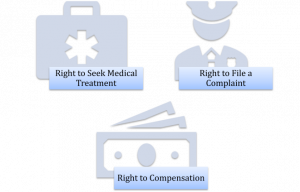[Trigger Warning: The following content contains information on physical violence which some readers may find disturbing.]
The crimes relating to acid attacks have been specified under the Indian Penal Code, 1860 and the Code of Criminal Procedure, 1973. Anyone can be punished for the crimes given below regardless of their gender. They are:
Throwing acid or attempting to throw acid
Throwing acid on a person and hurting them is a crime. The punishment for throwing acid is jail time of minimum 10 years that can be extended to life imprisonment along with a fine that is reasonable enough to meet the medical expenses of the acid attack survivor.(( Section 326A, Indian Penal Code, 1860.))
Additionally, throwing or attempting to throw acid on a person is also a crime. The punishment is jail time of a minimum of 5 years and can be extended to 7 years, along with a fine.(( Section 326B, Indian Penal Code, 1860.))
Helping someone throw acid
Helping someone throw acid is also a crime. Helping someone commit a crime is known as abetment under the law. The punishment for abetment is the same as the punishment for throwing(( Section 326A, Indian Penal Code, 1860.)) or attempting to throw acid(( Section 326B, Indian Penal Code, 1860; Section 109, Indian Penal Code, 1860.)) on another person.
Refusing to treat or provide free immediate treatment to an acid attack survivor
An acid attack survivor has a right to medical treatment and a hospital refusing to provide such treatment is a crime under the law. A complaint can be filed before the police against a person who refuses to treat the survivor.(( Section 357C, Code of Criminal Procedure, 1973.))
Besides the specific acid attack crimes in the Indian Penal Code, 1860, other crimes can also be implicated or written in the FIR or charge sheet by the police in the case of acid attacks. These include murder,(( Section 325, Indian Penal Code, 1860.)) attempt to murder,(( Section 307, Indian Penal Code, 1860.)) hurting someone with dangerous weapons,(( Section 324, Indian Penal Code, 1860.)) and causing grievous hurt.(( Section 325, Indian Penal Code, 1860.))
